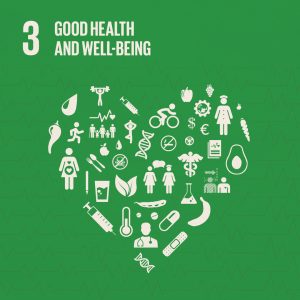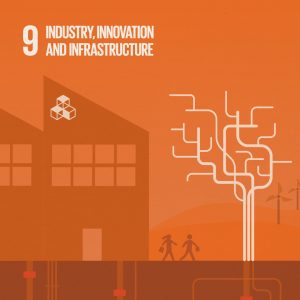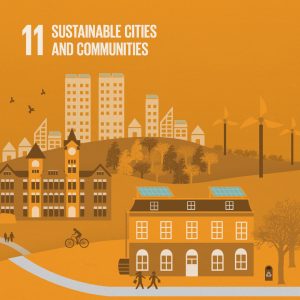“We shape our buildings, and afterwards our buildings shape us.” Winston Churchill
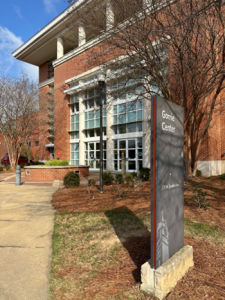
The M. Miller Gorrie Center received LEED certification in 2008. Photo credit: Jen Morse.
Modern humans in modern surroundings spend almost all of their time indoors. According to the Environmental Protection Agency (EPA), North Americans, on average, spend 87% of their time in buildings and 6% in enclosed vehicles, leaving only 7% of their lives to be spent outside. That is about 90 minutes a day. And let’s face it: Some of that time is spent walking between buildings or from cars to buildings and vice versa.
Spending so much time indoors can have significant health implications. In addition to the deleterious effects of being so separated from the natural world, indoor air quality (IAQ) is a significant issue. An average adult breathes about 4,000 gallons of air a day. For most of us, that means a vast majority of the air we breathe is indoor air. Given that indoor air can be five times more polluted than outdoor air (and sometimes much higher), this is an issue that deserves our attention.
What pollutes indoor air? According to the Centers for Disease Control, sources include asbestos, biological agents like mold and mildew, building materials, radon, tobacco smoke, HVAC systems, and in home settings, wood stoves, gas ranges, and other heating devices.
IAQ and its impacts on our health and well-being have not always been an issue. On the contrary, this is a very recent condition in human experience. Very recent.
In the book Rooted, by Lyanda Lynn Haupt, the author quotes Professor and researcher Yoshifumi Miyazaki who writes that “humans have evolved into what they are today after the passage of 6 to 7 million years….less than 0.01% of our species’ history has been spent in modern surroundings. Humans have spent over 99.99% of their time living in the natural environment.” Haupt goes on to explain that, according to Miyazaki, “modern humans are responding to the evolutionary sudden immersion in artificial and urbanized environments by operating in a constant stress state.”
Before the 1970s, not much thought was given to the makeup of building components, the quality of air that building inhabitants were breathing, or the impacts of IAQ on human health. In 1984 the World Health Organization concluded that up to 30% of new and remodeled buildings had sufficient IAQ problems to cause health impacts and created the term “sick building syndrome” to describe the impacts of regularly breathing airborne contaminants.
According to an EPA fact sheet: “The term ‘sick building syndrome’ (SBS) is used to describe situations in which building occupants experience acute health and comfort effects that appear to be linked to time spent in a building…. Building occupants complain of symptoms associated with acute discomfort, e.g., headache; eye, nose, or throat irritation; dry cough; dry or itchy skin; dizziness and nausea; difficulty in concentrating; fatigue; and sensitivity to odors.”
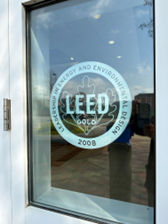
LEED Gold certification plaque at the M. Miller Gorrie Center. Photo credit: Jen Morse.
In 1993 a small group of architects decided there had to be a better, more intentional way to design, construct, and operate buildings with nature and people in mind and formed the U.S. Green Building Council (USGBC) to make that happen.
From the USGBC website: “USGBC’s vision is that buildings and communities will regenerate and sustain the health and vitality of all life within a generation. USGBC’s Mission, to transform the way buildings and communities are designed, built, and operated, enabling an environmentally and socially responsible, healthy, and prosperous environment that improves the quality of life, builds on this vision through the development and improvement of the LEED rating system.”
LEED (Leadership in Energy & Environmental Design) certified buildings are more environmentally responsible, can be designed for optimal energy and water use efficiency, and they provide healthier environments to support the wellbeing of the people who inhabit them.
The LEED rating system is the world’s most widely used standard for certifying responsible design, construction, and operation of buildings. LEED certification is earned at four levels of building performance: Certified, Silver, Gold, and Platinum.
This graphic illustrates the LEED system goals:
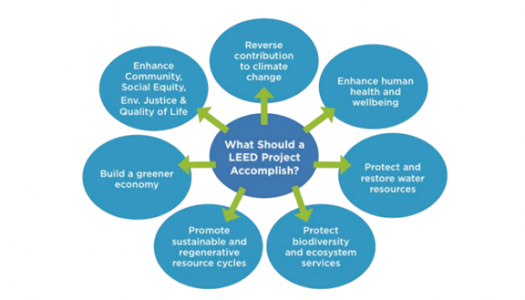
Photo credit: USGBC
The certification aspect of LEED is of critical importance. LEED certification provides third-party verification that human health, environmental responsibility, and other performance goals of building projects have been achieved. LEED certified buildings make a public statement about commitment to sustainability. As USGBC puts it, “LEED certification is a globally recognized symbol of sustainability achievement and leadership.”
Auburn University is a member of USGBC and is committed to building LEED-certified buildings. Auburn’s standard is to achieve LEED Silver certification (or its equivalent) at a minimum. The recently constructed Gogue Performing Arts Center achieved a LEED Gold certification. This is a significant accomplishment for performing arts centers due to their high energy demand and the challenge of making them sufficiently energy efficient.
The most eye-popping benefits of LEED-certified buildings are their positive impacts on cognitive ability and improvement in sick building syndrome. To see them check out The Impact of Green Buildings on Cognitive Function studies website.
In a nutshell: “New studies from the Harvard T.H. Chan School of Public Health’s Center for Health and the Global Environment, SUNY Upstate Medical University and Syracuse University have found that improved indoor environmental quality doubled occupants’ cognitive function test scores. Additionally, occupants in high-performing, green-certified buildings had higher cognitive function scores than occupants in similarly high-performing, non-certified buildings.”

LEED plaque installation at the Center for Advanced Science, Innovation, and Commerce (CASIC) Building. Photo credit: Jen Morse.
These studies show that people who work in LEED-certified buildings experience:
- 26.4% improvement in cognitive ability
- 30% reduction in sick building syndrome
- 6.4% improvement in nighttime sleep quality
Wow!
Since the State of Alabama removed restrictions on building LEED-certified buildings, every newly constructed and significantly renovated building at Auburn has been LEED certified. Bravo!
Recently, a Facilities Management team completed a project to denote with plaques and decals all of Auburn’s LEED-certified buildings.
The M. Miller Gorrie Center deserves special note as the first building on Auburn’s campus to receive LEED certification, and impressively it was certified as LEED Gold. It was also one of the first LEED Gold-certified buildings in Alabama. When it was built, the 36,000 square foot Gorrie Center changed how facilities were designed and built on Auburn’s campus, and today the building continues to be a leader in educational technology. On the first floor, close to the entrance of the building, is a digital floor plan which points out energy-saving features of this building.
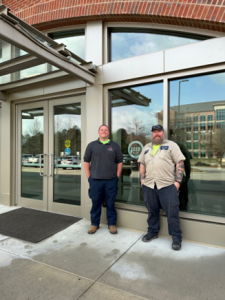
Chase Kilpatrick (left) and Jason Yeomans (right) completed sign installation at the CASIC Building. Photo credit: Jen Morse.
These building plaques and the achievements they represent tell important stories about Auburn’s commitments to facilities that provide performance-enhancing environments that nurture the health and wellbeing of building occupants.
LEED-certified buildings also deliver environmental benefits related to sourcing materials, sustainable sites, and so on. But that’s a topic for another day.
Twenty years after it was discovered that indoor air quality, access to natural light, and other building factors impact human health and performance, a small group of architects set out to “transform the way buildings and communities are designed, built, and operated, enabling an environmentally and socially responsible, healthy, and prosperous environment that improves the quality of life….”
In the process, they transformed the profession of architecture and catalyzed a movement toward healthier and environmentally responsible buildings that continues to grow and improve, demonstrating that, indeed, green-certified buildings are good for you!
Learn about the SDGs & AU and our contributions related to this post.

